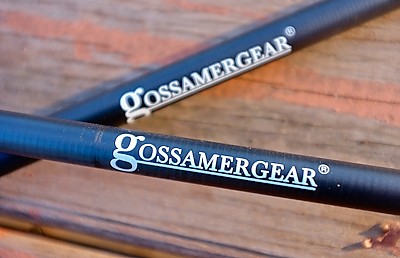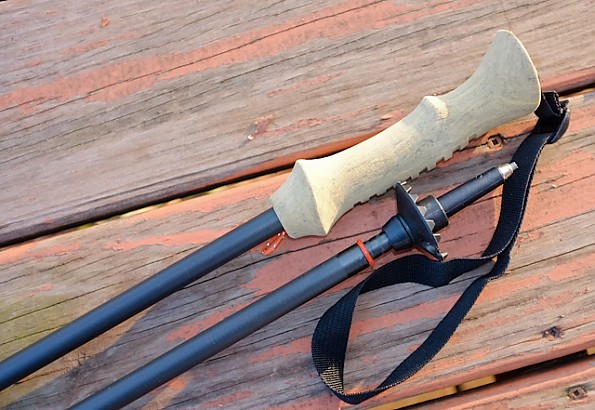Gossamer Gear Lightrek 4
The Lightrek 4 has been discontinued. It was replaced by the Gossamer Gear LT5 Three Piece Carbon Trekking Poles.
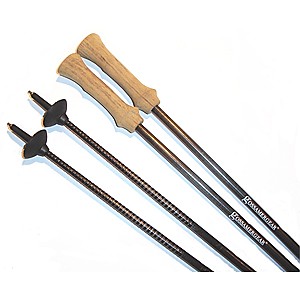
Light, strong, and useful.
Pros
- Sturdy when used as poles should be used
- Ultralight
- Can double as tent poles
- Great customer service from the mfr
Cons
- Carbon fiber can break if pressure is applied to the poles horizontally
My first pair of trekking poles lost the ability to lock—they were twist locking poles from a major manufacturer. Calling or emailing the company for help went nowhere. I couldn't find a number or email address anywhere.
My second pair were the Lightrek 4s, not a casual purchase. They are expensive and don't go on sale. But, I've had them for a long time, and I'm still using them.
Why use trekking poles? For one, they take 6 lbs of weight off your joints per step when used properly. (There are Youtube videos on how to use poles for Nordic walking, helping to propel you forward on level ground.) For another they've kept me from face planting on numerous occasions, tripping over a root, or having pebbles shoot out from under my foot unexpectedly.
I use them in my light tent, instead of tent poles. I use them on stream crossings—four "legs" is so much better for stability in swift, knee deep water. I've used them to increase reach, shoving snakes out of the trail. I've used them to fend off random ill-mannered dogs. I use them climbing hills to lever my short-ish self up those stupid tall stone steps that trail crews insist on putting in national park trails. I've used poles on cross country traverses in steep terrain. I've used them to brake myself going down very steep slopes.
I broke one of the poles, but it was accidental abuse. Putting them in the trunk then letting friends put their gear in after led to a pack being shoved down on top of one of the collapsed poles. Both sections broke. I bought another pole. Other than this breakage, the poles have lasted for more than ten years.
My very tall (he wears size shoe 17.5) boyfriend used aluminum poles at the behest of his doctor, until he left them at a trailhead somewhere. He borrowed mine for a hike, came home, ordered the same poles only in a fixed length custom to his height. He loves them.
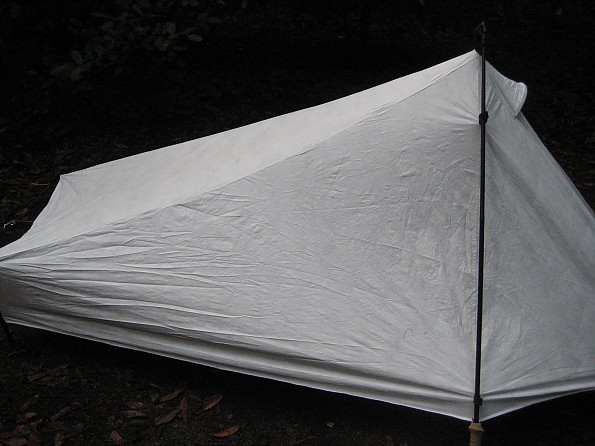
This appears to be a picture of a tent. It is in fact a picture of my trekking poles holding up a Tarptent Sublite in Tyvek (discontinued). The tent weighs 14 oz. The poles weigh 8 (4 oz per pole). (The Tyvek is alas not waterproof, making this a very poor choice for people who go camping when it rains heavily. It is however a great tent for those quick overnights with no precip in the forecast, when you just want to keep the bugs off.) The poles are standing up to a lot of tension put on them—in the correct direction, along the vertical axis of the poles.

This is another picture that appears to be of a tent—two Lightheart Gear tents, in fact. Both are being held up by trekking poles, but with these tents the poles go inside. The one closest to the camera is my tent, held up by Gossamer Gear Lightrek 4 poles.
What makes these poles worth the money to me is the fact that the twist lock mechanism is nothing like the ones in mass manufactured poles. If for some reason the locks don't immediately lock, pulling apart the pole and moving the black rubber cylinder down against the top section then putting the pole together results in a solid lock. User fixable, field fixable, strong twist locks make these poles my choice for backpacking trips.
I don't use straps with my poles. I know people are told to put their weight into the straps, but that only makes my wrists hurt. I grip the handle tightly when putting weight on the pole and loosen my grip when swinging it forward. It works for me.
The carbide tips work like those on any trekking pole. Less useful on granite slab, most useful on granitic sands and dirt which is what I'm hiking on 99.9% of the time.
I replace a lot of gear, since I'm always out hiking somewhere and everything has a lifespan. These poles are one of a few exceptions. Lately I've been leaving the poles home when I day hike. However, they are my constant companion on backpacking trips and they've never failed to catch me if I start to fall.
I have heavy aluminum poles with snow baskets for snowshoeing, as I know that cold can make carbon fiber brittle and sometimes when using poles in snow I end up twisting them; too much pressure from side to side is too much abuse. I'd rather bend a cheap pair of aluminum poles than snap another Lightrek pole.
The customer service at GG is excellent. I emailed them about replacement handles—a marmot chewed off the faux cork on one pole—and was asked to send in the pole for a free replacement, which they did quickly and sent back the pole within a week. So much happier with that than searching fruitlessly for a phone number without success!
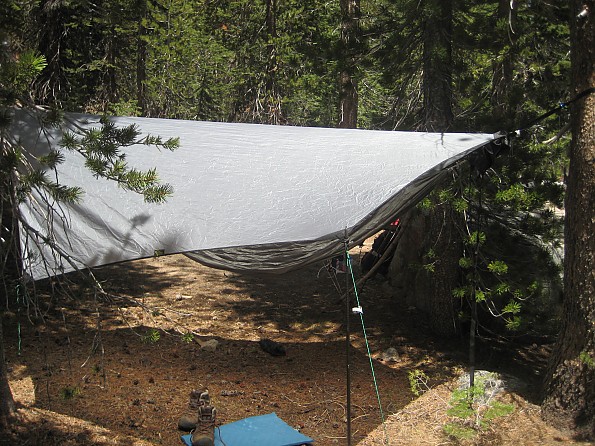
One of the GG Lightrek poles holding up a corner of the tarp over my hammock. Extending the poles to the desired length, I can use them to create more of a view from the hammock.
Two thumbs up to Gossamer Gear. They made a repeat customer out of me.
Source: bought it new
Price Paid: $150
Insanely light, exceptionally comfortable, crazy expensive trekking poles that needs lots of TLC, and that I found too fragile for klutzes in mountainous terrain.
Pros
- Wicked light
- Comfortable, ergonomic handles
- Adjustable across a wide range
Cons
- Expensive to purchase
- Requires routine maintenance
- Repair parts expensive
- Carbon fiber snaps under heavy stress
- Do not collapse small enough to fit inside pack
When I began looking at reducing the overall weight I’d be humping while hiking the Appalachian Trail, I started hearing about new, lighter hiking poles. My old Black Diamond poles weighed 18 ozs, and they seemed a good candidate for lightening.
Besides using them to help propel me up mountains, slow me down when going down them, and providing balance in stream crossings, I planned on having them hold up my tent. So, whatever I chose would have to be adjustable from about 115cm where I like to cruise, to at least 130 cm to work with my tent.
BD came out with a new line called Distance trekking poles that fold up like avalanche poles. They come in both fixed lengths, and in an adjustable version using a flick-lock. The weighed from 15.2 to 16oz a pair, depending on length, and list at $119.95. Which seemed like a lot to pay to save 2 ozs ... But more importantly, the one length they had that extended far enough to support my tent (120-140cm), did not collapse enough to support me in the manner to which I have become accustomed.
Enter GG LT4s - Then someone in a hiking forum professed his loved for his GossamerGear's Lightrek 4 adjustable carbon fiber trekking poles. Adjustable from 90cm to 140cm, and weighing only 7.2 oz a pair - That's right, I said a pair! Less than half the weight of my good ole BDs! Online reviews were all positive, and implied that they are as rock solid as the BD flick locks.
And in a bonus for me, the wrist straps are attached to the top of the poles with screws, and when taken off, an optional camera adapter can be screwed in. I could leave a few ounces of camera support at home!
My Experience - One downside is that they only collapse to about 33” making them too long to fit inside my pack. Another is that they are really spendy, and shipping is spendy. The price quoted on their page is for a single pole ... Once I worked thru the five stages of grief I go through with any such purchase, I ordered a pair from their website, along with the optional camera adapter. They arrived a few days later, unscathed in a heavy-duty cardboard tube.
My first reaction was how beautiful they are in their simplicity. Matte black shafts, uncluttered by locking mechanisms, tan ergonomic handles, and robust looking tips. Then I was blown away by their weight. Or rather, their lack thereof. I found the poles adjusted easily, requiring only a couple of twists to lock them securely. The "Kork-o-lon" grips were very comfortable.
I hiked 114 miles thru Georgia and into North Carolina on the AT with these poles, and had no problems. They held securely, adjusted easily, and held my tent up perfectly.
I went home with an injury, and started again southbound from Maine. My second day in the 100-Mile Wilderness, I sunk up to my knee in a deep mud puddle, along with one of my poles. I lost my balance, fell forward, and snapped the lower section right where it met the upper section. A phone call to GG from a mountaintop had another lower section waiting for me in Monson, for $45 plus shipping.
Meanwhile, with about 230 miles on them, the other pole started getting hard to adjust. Then nearly impossible. The rubber expander had begun to deteriorate, and was getting sticky. I was ultimately unable to adjust the pole. Emails to GG resulted in them sending me a rebuilt lower pole section from their “hiker box” in exchange for the old section. Plus shipping.
A few days later, I was descending Wildcat Mountain in the rain. I slipped on exposed rockface and fell on my butt. One of the poles was behind a rock, and snapped on my way down. This time an upper section ...
In 434 miles I had to replace three sections - two of which requiring me to whip out a credit card. To be fair, they were some tough, mountainous miles. But, it occurred to me that the "Light" in "Lightrek" is as much a reference to the type of hiking for which they are designed, as to their weight.
Well, at least that’s what I preferred to think, rather than, you know, the possibility that I was just too dam hard on 'em ...
At that point, I shipped those parts home, and bought a set of Lekis at a local outfitter to get me thru the Presidentials and points south…
A High Maintenance Relationship - These poles need regular maintenance. Separate the poles when not in use, clean them regularly. Still, replacing a worn out tip means purchasing a "Replacement Tip Section" which includes the whole bottom section of the pole for $45. Replacing both would be $90 plus shipping… Replacing expanders … The life-cycle cost of these could be astounding. I had them for a year, and they cost me $331.
Bottom Line: I replaced that broken upper section, and I'll use the LT4s for hiking in less than hairy, wet, mountainous conditions.
Source: bought it new
Price Paid: $175 plus shipping
You cannot count on these poles to lock everytime.
Pros
- LOVE the light weight
- Great hand grips
Cons
- Not dependable to lock.
- Very expensive for something that you cannot count on.
I bought these poles spring of 2011. From the beginning I had trouble getting them to lock. Being I use them for my tent support I found it most frustrating.
Sometimes it would only take twisting them for a few seconds or a minute, other times I would work on it up to 10 minutes. At that time it finally worked or I just gave up. I could get one to lock but not the other one, or both.
Sometimes if I wetted the inside lock rubber washer it would catch. Several times I had to hike with one pole or none because of them not locking. I have had to look for branches to set my tent up with. Being many other people have also had this same problem I don't understand why they don't fix the problem at Gossamer Gear.
Source: bought it new
Price Paid: $160

This is the collapsible version of the Gossamer Gear Lightrek 3 poles and aside from the weight -- the 4's weigh a half oz. more than the 3's -- there isn't a lot of difference between the two. Both are made of ultralight graphite fiber composite.
These poles are so light that you'll never get over how light they are. What sets one collapsible pole apart from another is grip comfort, strength, ease of adjustment and weight.
When it comes to weight, other collapsible poles don't come close to these. They weigh 3.4 oz. each! The amazing thing is, this doesn't appear to come as a result of a compromise with strength. I put a lot of weight on them especially on steep, rocky descents and they take it.
As far as comfort goes, they're winners. The soft grips keep discomfort and fatigue to a minimum. When I'm descending, I usually have the top of the grip against my palm the way I'd use a cane to support my weight. The wide soft top distributes the load across my hand for maximum comfort.
The adjustment locking is of the twist-to-tighten variety. I much prefer a lever lock for speed and reliability, but at Gossamer Gear, weight gets priority and the levers add weight. That said, I've found that once locked, they stay locked so it hasn't been a problem. I don't use my poles to hold up a tent so I'm not adjusting them twice a day, just at the beginning and end of the trip. The first time I used these poles, one pole wouldn't lock. I slipped the bottom section out and tightened the adjuster about a quarter turn, expanding it enough to grab the top section. I haven't experienced a recurrence.
Price Paid: $160
After hiking over 8,000 miles in the last decade I have come to appreciate product quality and ingenuity. Gossamer Gear’s Lightrek 4 Trekking poles give me everything I need from poles (balance, support, ease) but with the added benefit of not weighing a lot.
They are so light that when I am not using them, say to grab a snack or read my map, I just tuck them under my arm and forget about them. Or if I'm in a town or on asphalt, I break them down and put them in my pack. It’s nice not to have the extra weight of heavier poles. And yet, I still use them to catch me when I trip, to leapfrog over streams, for balance as I tear down steep mountains and for support as I head up them.
One of my favorite design features are the comfortable soft handles that are shaped so that I can keep switching my grip to four different positions. It keeps my wrists from getting sore. The poles have become an extension of my body as I hike, I forget about them, yet would miss them if they were gone.
Feather light adjustable trekking poles with a comfortable cork-like grip.
Pros
- Light
- Comfortable
- Sturdy
Cons
- Long for packing
I never knew I needed ultralight trekking poles until I had the Gossamer Gear LT4S trekking poles. Not only are they feather light, but they have a substantial cork-like grip that is exceedingly comfortable.
Once you start weighing gear, it’s hard to go back. I’ve been trying to lighten my load, but I’m mostly focused on what goes on my back. I never really thought about my trekking poles. Once I got the Gossamer Gear poles in my hands, I could see what a difference they make.
The LT4S poles weigh only 5 oz per pole (with strap and small baskets), on my kitchen scale. In contrast, my REI Shocklight Staff weighs 10 1/8 oz per pole, more than double.
The LT4 pole comes with or without a wrist strap. With the strap, it’s known at the LT4S. The strap weighs 3/8 oz. Note that a strap cannot be added to the LT4.
The LT4 and LT4S pole is made from carbon fiber with a carbide tip. The bottom eight inches has a spiral wrap, designed to strengthen that section. They are adjustable from 90 cm to 135 cm for hiking, but go up to140 cm if needed to set up a shelter. The pole is 84 cm when completely closed. They come with small baskets and accept Leki brand baskets. The grips are made from Ethylene-Vinyl Acetate (EVA) "Kork-o-lon". One bonus is that the pole floats in water. If you drop it in a stream, it won’t sink like a rock.
The poles are adjustable with a simple twist lock. There is no external locking mechanism; the pole is completely smooth. There is one adjustment point, which saves weight over two but also makes the pole a bit longer. This can be an issue when packing for air travel.
I’ve been testing the poles for several months through the winter. I always use trekking poles when backpacking but not for day hikes. I found myself using these poles on day hikes often because they were so light and unobtrusive. There are several stream crossings on my regular winter hiking routes and having the trekking poles gives me a lot more stability when rock hopping.
I like having a strap because it’s just my luck that I’ll drop a pole at the most inopportune time, usually on a skinny, exposed trail when I’m concentrating really hard to not fall off the mountain. I like the clean lines of the pole with no external protuberances to catch on anything or scratch my legs. I find the contoured foam handles very comfortable, as good or better than cork.
The pole and the components appear to be sturdy and reliable, but I was glad to see several replacement parts on the Gossamer Gear website, including tips, pole grips, baskets and straps. There is also a StickPic Selfie adaptor and a bungee cord for attaching the pole(s) to a backpack.
I’m impressed with the Gossamer Gear LT4S Trekking Poles and look forward to using them this summer on my backpacking trips to the Sierra. I’m happy to cut my pole weight in half.
Source: tested or reviewed it for the manufacturer (I kept the product after testing.)
Your Review
You May Like
Specs
| Price |
Reviewers Paid: $150.00-$175.00 |
| Weight per pole |
3.3 oz (Short), 3.4 oz. (96 g) (Regular) |
| Weight trekking baskets |
0.4 oz (11 g) each |
| Length |
Short adjustable from 85 cm (33 in) to 125 cm (49 in), Regular adjustable from 90 cm (35.5 in) to 140 cm (55 in) |



